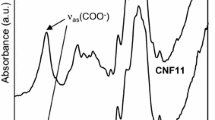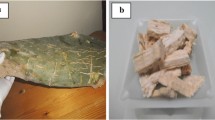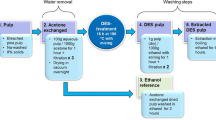Abstract
An industrial calcium sulfite pulp was fractionated in a hydrocyclone to four fractions that differed in dimensions and composition due to differences in density. The intention was to investigate whether the fibre dimensions had any influence on the properties of carboxymethyl cellulose (CMC) produced from the fractions and especially how the properties of the unreacted material differed. It was surprisingly found that the fraction containing thin-walled fibres gave CMC and dissolved residuals in the CMC-solution that had the lowest degree of substitution (DS). It was therefore believed that the thin-walled fibres were collapsed and more closely bound in the fibre network after drying of the pulp and that this impeded the chemical diffusion in the subsequent CMC-process, i.e. the diffusion of the CMC-chemicals into the cell wall was slower. There was thus a correlation between thinner fibres and a lower degree of substitution for CMC made from such fibres. It was also found that tick-walled fibres had a higher degree of substitution than the thin-walled fibres but that the highest degree of substitution was obtained if a mixture of thin- and thick-walled fibres were used.
Similar content being viewed by others
References
T. Hausalo (1995) Analysis of Wood and Pulp Carbohydrates by Anion Exchange Chromatography with Pulsed Amperiometric Detection 8th International Symposium on Wood and Pulping Chemistry HelsinkiFinland
T. Heinze U. Erler I. Nehls D. Klemm (1994) ArticleTitleDetermination of the substituent pattern of heterogenously and homogenously synthesized carboxymethyl cellulose by using high-performance liquid chromatography Angew. Makromol. Chem. 215 93–106
H.G. Higgins A.W. McKenzie (1963) ArticleTitleThe structures and properties of paper. xiv. Effects of drying on cellulose fibers and the problem of maintaining pulp strength Appita 16 145–164
G.C. Hoffman T.E. Timell (1972) ArticleTitlePolysaccharides in ray cells of normal wood of red pine (Pinus resinosa) Tappi J. 55 733–736
S. Horner J. Puls B. Saake E.-A. Klohr H. Thielking (1999) ArticleTitleEnzyme-aided characterisation of carboxymethylcellulose Carbohydr. Polym. 40 1–7
M.-J. Ilvessalo-Pfäffli (1995) Fiber Atlas – Identification of Papermaking Fibers Springer Verlag Berlin, Germany 15–16
J. Jansson (1974) ArticleTitleAnalytik der polysaccharide in Holz und Zellstoff Faserforsch. Textiltechn. 25 375–382
Jardeby K., Germgård U., Kreutz B., Heinze T., Heinze U. and Lennholm H. 2005. Effect of pulp properties on the characteristics of undissolved residuals in CMC-solution. Submitted to Cellulose.
K. Jardeby H. Lennholm U. Germgård (2004) ArticleTitleCharacterisation of the undissolved residuals in CMC-solutions Cellulose 11 195–202
E.D. Jones R.T. Campbell G.G. Nelson (1966) ArticleTitleSpringwood-summerwood separation of southern pine pulp to improve paper quality Tappi 49 410–414
P. Käuper W.M. Kulicke S. Horner B. Saake J. Puls J. Kunze H.-P. Fink U. Heinze T. Heinze E.-A. Klohr H. Thielking W. Koch (1998) ArticleTitleDevelopment and evaluation of methods for determinating the pattern of functionalization in sodium carboxymethylcelluloses Angew. Makromol. Chem. 260 53–63
D. Klemm B. Philipp T. Heinze U. Heinze W. Wagenknecht (1998) Functionalization of Cellulose. Comprehensive Cellulose Chemistry Vol. 2. Wiley-VCH, Weinheim Germany 207–210
B. Krogerus K. Fagerholm E. Tiikkaja (2002) ArticleTitleFines from different pulps compared by image analysis Nord. Pulp Paper Res. J. 17 440–444
T. Liebert T. Heinze (2001) ArticleTitleExploitation of reactivity and selectivity in cellulose functionalisation using unconventional media for the design of products showing new superstructures Biomacromolecules 2 1124–1132
T. Lindström G. Carlsson (1982) ArticleTitleThe effect of carboxyl groups and their ionic form during drying on the hornification of cellulose fibers Svensk Papperstidn. 85 R146–R151
N. Olaru L. Olaru (2001) ArticleTitleInfluence of organic diluents on cellulose carboxymethylation Macromol. Chem. Phys. 202 207–211
L. Paavilainen (1992) ArticleTitleThe possibility of fractionating softwood sulfate pulp according to cell wall thickness Appita ␣ 319–326
O. Perilä T. Seppä (1960) ArticleTitleCarbohydrates of spruce cells The chemical composition of wood cells II. Soumen Kemi. B33 114–116
B. Saake S. Horner J. Puls T. Heinze W. Koch (2001) ArticleTitleA new approach in the analysis of the substituent distribution of carboxymethyl celluloses Cellulose 8 59–67
J. Stawitz M.P. Kage (1959) ArticleTitleÜber die Quellungsstadien der wasserlöslichen Celluloseäther und die übermolekulare Struktur der Cellulose Das Papier 13 567–572
T. Törnqvist (1990) Juvenile Wood in Coniferous Trees Department of Forest-Industry – Market Studies UppsalaSweden 2, 56
Vomhoff H. and Grundström K.-J. 2003. Fractionation of a bleached softwood pulp and separate refining of the earlywood- and latewood-enriched fractions. Int. Papwirtsch.: 37--41
L. Xiquan Q. Tingzhu Q. Shaoqui (1990) ArticleTitleKinetics of the carboxymethylation of cellulose in the isopropyl alcohol system Acta Polym. 41 220–222
Author information
Authors and Affiliations
Corresponding author
Rights and permissions
About this article
Cite this article
Jardeby, K., Germgård, U., Kreutz, B. et al. The influence of fibre wall thickness on the undissolved residuals in CMC solutions. Cellulose 12, 167–175 (2005). https://doi.org/10.1007/s10570-004-1371-9
Received:
Accepted:
Issue Date:
DOI: https://doi.org/10.1007/s10570-004-1371-9




